Maths Olympiad Model Test Papers -1 | Maths Olympiad Class 6 PDF Download
| Table of contents |

|
| Logical Reasoning |

|
| Mathematical Reasoning |

|
| Everyday Mathematics |

|
| Achievers Section |

|
Note: The questions provided in this document are similar to the questions that were asked in the actual Olympiad exam. So, we recommend you study these for your Olympiad preparation
Logical Reasoning
Q1: Jatin is the brother of Rahul. Yash is the father of Jatin and Suman is the sister of Yash. How is Suman related to Rahul?
(a) Sister
(b) Aunt
(c) Mother
(d) Cousin
 View Answer
View Answer 
Ans: (b)
- In this scenario, Jatin and Rahul are siblings, meaning they share the same parents.
- Yash is their father, and Suman is the sister of Yash, making her the aunt of Jatin and Rahul.
- Thus, Suman is related to Rahul as his aunt.
- This relationship is established through the family connection of Yash being the father and Suman being his sister.
Q2: If ‘#’ represents ‘×’, ‘$’ signifies ‘÷’, ‘@’ indicates ‘+’ and ‘©’ stands for ‘–’, what is the result of 125$5@14#5©15#3?
(a) 60
(b) 50
(c) 40
(d) 80
 View Answer
View Answer 
Ans: (b)
- First, replace the symbols with their respective operations: 125 ÷ 5 + 14 × 5 - 15 × 3.
- Now, perform the calculations step by step: 125 ÷ 5 equals 25.
- Next, calculate 14 × 5 which gives 70, and 15 × 3 equals 45.
- Now, combine these results: 25 + 70 - 45 equals 50.
Q3: Select the item that does not belong with the others.
(a) Iron
(b) Wood
(c) Aluminium
(d) Silver
 View Answer
View Answer 
Ans: (b)
- The question asks for the odd one out among the options.
- Iron, Aluminium, and Silver are all metals, while Wood is a natural material from trees.
- This makes Wood different from the other three, which are all metallic elements.
Q4: Which of these sequences follows the pattern where the sum of any two consecutive terms is less than 8 and all terms are different??
(a) 7, 1, 2, 6, 5, 4
(b) 6, 1, 5, 2, 4, 3
(c) 7, 0, 2, 6, 5, 4
(d) 7, 0, 2, 6, 2, 4
 View Answer
View Answer 
Ans: (b)
Q5: Which would be the first term of the given sequence that would be lesser than 20: 67, 61, 55, 49, ..... ?
(a) 17
(b) 18
(c) 19
(d) 20
 View Answer
View Answer 
Ans: (c)
Q6: What should be the next term in this sequence:
M10G, K9G, I8G, _________ ?
(a) G7I
(b) H7G
(c) G7G
(d) F7G
 View Answer
View Answer 
Ans: (c)
Q7: I am father of Rishi. Heera is Rishi's mother's only daughter. What will be the relation of Heera's husband with me?
(a) Son
(b) Uncle
(c) Son-in-law
(d) Brother
 View Answer
View Answer 
Ans: (c)
Q8: Which of these pairs form a new word each on dropping a common letter?
(a) first, fist
(b) fashion, fill
(c) tease, tray
(d) sick, sell
 View Answer
View Answer 
Ans: (c)
Q9: How many triangles are there in the given figure?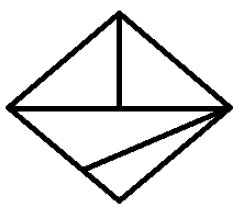 (a) 4
(a) 4
(b) 5
(c) 6
(d) 8
 View Answer
View Answer 
Ans: (c)
Q10: If X is the brother of the son of Y’s son, how is X related to Y?
(a) Grandson
(b) Son
(c) Cousin
(d) Cannot be determined
 View Answer
View Answer 
Ans: (a)
Q11: In which of the four images the symbol ‘X’ CANNOT be found as a part of that image?
(a) 1
(b) 2
(c) 3
(d) 4
 View Answer
View Answer 
Ans: (d)
Q12: Find the next element of the following series:
4, 10, 22, 40, 64,?
(a) 80
(b) 94
(c) 86
(d) 100
 View Answer
View Answer 
Ans: (b)
Q13: How many meaningful words of four letters can be formed by using the first, third, fifth and eighth letter of the alphabetical series using each letter only once?
(a) Two
(b) One
(c) Three
(d) None
 View Answer
View Answer 
Ans: (a)
Q14: Choose the box that will be formed by folding the sheet of paper given in fig(i).
(a) Only (ii)
(b) Only (iv)
(c) Only (v)
(d) Only (ii) and (iii)
 View Answer
View Answer 
Ans: (d)
Q15: The following figure shows three intersecting circles representing Cricketers, Males and Coaches. Different regions so obtained in the figure are marked 1, 2, 3, 4, 5, 6 and 7. If you are to select the males who are not coaches, then which region is to be selected?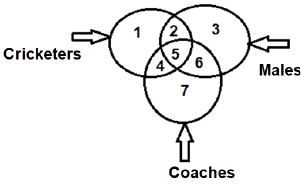
(a) 7
(b) 5
(c) 13
(d) 9
 View Answer
View Answer 
Ans: (b)
Mathematical Reasoning
Q16: The equation _________ and 2x + 2 = 0 have the same solution.
(a) x – 1 = 0
(b) x + 1 = 0
(c) x – 2 = 0
(d) x + 2 = 0
 View Answer
View Answer 
Ans: (b)
- To find the solution of the equation 2x + 2 = 0, we can simplify it:
- Subtract 2 from both sides: 2x = -2.
- Now, divide by 2: x = -1.
- We need to find which equation has the same solution. The equation x + 1 = 0 also simplifies to x = -1.
- Thus, both equations have the same solution of x = -1.
Q17: Which of the following statements is false?
(a) 42.6 > 36.617 > 36 > 20.123
(b) 16.124 < 23.45 < 23.57 < 77
(c) 65.124 > 33.112 > 27 > 23.6
(d) 99.999 < 99.99 < 99.8 < 99
 View Answer
View Answer 
Ans: (d)
- The statement in option (d) is incorrect because it claims that 99.999 is less than 99.99, which is not true. In reality, 99.999 is greater than 99.99.
- In contrast, the other options are correct as they accurately represent the relationships between the numbers.
- Understanding the symbols < and > is crucial; they indicate whether one number is less than or greater than another.
- Thus, option (d) is the only false statement among the choices provided.
Q18: When we multiply a whole number by the multiplicative identity of whole numbers, the result is _____.
(a) The number itself
(b) The multiplicative identity
(c) 0
(d) The opposite of that number
 View Answer
View Answer 
Ans: (a)
- When you multiply any whole number by the multiplicative identity, which is 1, you will always get the number itself.
- This means that if you take a number, say 5, and multiply it by 1, you still have 5.
- Thus, the correct answer is that the result is the number itself.
- Other options do not hold true in this case, as they suggest different outcomes.
Q19: How many of the letters listed below lack a line of symmetry?
P A R K I N G
(a) 5
(b) 4
(c) 6
(d) 3
 View Answer
View Answer 
Ans: (a)
- The letters in "P A R K I N G" are examined for lines of symmetry.
- Letters P, K, R, and G do not have any line of symmetry.
- Letters A, I, and N have at least one line of symmetry.
- Thus, a total of 5 letters lack symmetry.
Q20: If the number 87427*56 is divisible by 36, what digit should replace *?
(a) 3
(b) 2
(c) 6
(d) 7
 View Answer
View Answer 
Ans: (c)
- To determine what digit can replace *, we need to check the divisibility rules for 36, which requires the number to be divisible by both 4 and 9.
- For divisibility by 4, the last two digits (56) must form a number that is divisible by 4, which they do.
- For divisibility by 9, the sum of all digits must be divisible by 9. The sum of the digits in 87427*56 is 38 + *.
- We find that when * is 6, the total sum becomes 44, which is divisible by 9. Thus, * must be 6.
Q21: Which of the following sets of numbers are not in proportion?
(a) 7, 12, 805, 1380
(b) 16, 28, 4, 7
(c) 150, 100, 135, 90
(d) 51, 85, 57, 98
 View Answer
View Answer 
Ans: (d)
- The concept of proportion means that the ratios of the numbers should be equal.
- In option (d), the ratios do not match, indicating that these numbers are not in proportion.
- For example, if you compare 51 to 85 and 57 to 98, the ratios are different, confirming they are not proportional.
- Thus, option (d) is the correct answer as it does not maintain the same ratio as the others.
Q22: If the total of two angles exceeds 180°, which of the following combinations is not feasible for these angles?
(a) One obtuse angle and one acute angle
(b) One reflex angle and one acute angle
(c) Two obtuse angles
(d) Two right angles
 View Answer
View Answer 
Ans: (d)
- The sum of two angles being greater than 180° means they cannot both be right angles since two right angles add up to exactly 180°.
- Obtuse angles (greater than 90°) and acute angles (less than 90°) can combine to exceed 180°.
- A reflex angle (greater than 180°) combined with an acute angle can also exceed 180°.
- However, having two right angles will always equal 180°, making this combination impossible if the sum must be greater than 180°.
Q23: Which of the following indicates a negative integer?
(a) The temperature rises by 32°C.
(b) A deposit of ₹8469.
(c) A submarine is at a depth of 140 m below sea level.
(d) A bird is soaring at a height of 105 m above ground level.
 View Answer
View Answer 
Ans: (c)
- The question asks for a negative integer, which is a number less than zero.
- Option (c) describes a submarine that is 140 m below sea level, indicating a negative value.
- Options (a) and (b) represent positive values, while (d) describes a height above ground, which is also positive.
- Thus, the correct answer is (c) as it clearly represents a negative integer.
Q24: Calculate the total of all the prime factors of 1155.
(a) 26
(b) 28
(c) 22
(d) 24
 View Answer
View Answer 
Ans: (a)
- To find the prime factors of 1155, we start by dividing it by the smallest prime number, which is 3. 1155 ÷ 3 = 385.
- Next, we factor 385. It can be divided by 5 (the next prime), giving us 385 ÷ 5 = 77.
- Now, we factor 77, which can be divided by 7, resulting in 77 ÷ 7 = 11.
- Finally, 11 is a prime number itself. So, the prime factors of 1155 are 3, 5, 7, and 11.
- Adding these together: 3 + 5 + 7 + 11 = 26.
Q25: The value of 18 × 13 + 54 ÷ 2 – 8 is _______.
(a) CLLIII
(b) CCLIII
(c) CCVIII
(d) DCLIII
 View Answer
View Answer 
Ans: (b)
- First, calculate 18 × 13, which equals 234.
- Next, compute 54 ÷ 2, resulting in 27.
- Now, add these two results: 234 + 27 = 261.
- Finally, subtract 8 from 261, giving you 253.
- In Roman numerals, 253 is represented as CCLIII.
Q26: Set of three prime numbers is called a prime triplet, which of the following is a prime triplet?
(a) (2, 4, 5)
(b) (7, 9, 13)
(c) (5, 7, 11)
(d) (2, 3, 8)
 View Answer
View Answer 
Ans: (c)
Q27: What least number should be added to 2410 to get a number exactly divisible by 45?
(a) 30
(b) 10
(c) 20
(d) 15
 View Answer
View Answer 
Ans: (c)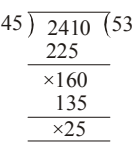
∴ Number = 45 – 25 = 20
Q28: How many triangles are there in the figure below?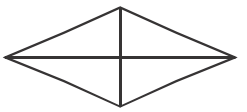 (a) 7
(a) 7
(b) 8
(c) 9
(d) 11
 View Answer
View Answer 
Ans: (b)
Q29: Which of the following pair of line segments are not parallel, as shown in the figure?
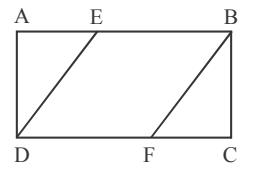 (a) AD, BC
(a) AD, BC
(b) AE, FC
(c) DE, BF
(d) AB, BC
 View Answer
View Answer 
Ans: (d)
AB and BC are adjacent sides.
Q30: What is the value of XL – XI?
(a) 29
(b) 30
(c) 20
(d) 49
 View Answer
View Answer 
Ans: (a)
XL – XI = 40 – 11 = 29
Q31: The value of 2575 ÷ 25 + 2575 ÷ 2575 is ________.
(a) 1
(b) 103
(c) 104
(d) 102
 View Answer
View Answer 
Ans: (c)
As 2575 ÷ 25 + 2575 ÷ 2575 = 103 + 1 = 104
Q32: State the property used in the following statement.
66 ×93+66×7=66×(93+7)
(a) Commutative property
(b) Associative property
(c) Distributive property
(d) Closure property
 View Answer
View Answer 
Ans: (c)
We have, 66 × 93 + 66 × 7 = 66 × (93 + 7)
This property is distributive property.
Q33: What is the product of 9680 × 10 × 14 × 0 × 8?
(a) 561260
(b) 642976
(c) 912040
(d) Zero
 View Answer
View Answer 
Ans: (d)
Any number multiplied by zero gives zero.
Q34: How many whole numbers are there between A and B on the number line? (a) 25
(a) 25
(b) 19
(c) 40
(d) 21
 View Answer
View Answer 
Ans: (b)
Here A = 10 and B = 30 The numbers from 11 to 29 lie between 10 and 30.
Q35: Which one of the following is the predecessor of 6+ 9 x 3-44?
(a) (-11)
(b) (-12)
(c) (-10)
(d) (-13)
 View Answer
View Answer 
Ans: (b)
6 + 9 × 3 -44
= 6 + 27 - 44
= 33 - 44
= (-11)
Predecessor = - 11 - 1 = - 12
Everyday Mathematics
Q36: Prerna had ₹5000. She purchased 2 boxes of chocolates for ₹52.98 each, 3 packets of chips for ₹12.98 each, and 2 books for ₹300.05 each. How much money does she have remaining?
(a) ₹4255
(b) ₹4750
(c) ₹4000
(d) ₹3875
 View Answer
View Answer 
Ans: (a)
- First, calculate the total cost of the chocolates: 2 boxes × ₹52.98 = ₹105.96.
- Next, calculate the total cost of the chips: 3 packets × ₹12.98 = ₹38.94.
- Then, calculate the total cost of the books: 2 books × ₹300.05 = ₹600.10.
- Add all these costs together: ₹105.96 + ₹38.94 + ₹600.10 = ₹744.00.
- Finally, subtract the total expenses from the initial amount: ₹5000 - ₹744 = ₹4256.
- Thus, the amount left with Prerna is ₹4256.
Q37: Riya takes a test consisting of 50 questions. She earns 4 marks for each correct answer, loses 2 marks for each incorrect answer, and receives 0 marks for questions she does not attempt. If Riya answers 30 questions, getting 17 correct and 13 incorrect, how many marks will she receive?
(a) 45
(b) 42
(c) 44
(d) 48
 View Answer
View Answer 
Ans: (b)
- Riya answered 30 questions in total.
- She got 17 correct, earning 4 marks each, which gives her 68 marks (17 x 4).
- She got 13 incorrect, losing 2 marks each, resulting in a deduction of 26 marks (13 x 2).
- Calculating her total: 68 marks (from correct answers) - 26 marks (from incorrect answers) = 42 marks.
Q38: The dimensions of the room are 42 meters in length and 18 meters in width. A carpet is required to cover the entire floor area.
Calculate the total cost of the carpet if it is priced at ₹6 per square meter.
(a) ₹4832
(b) ₹4536
(c) ₹4036
(d) ₹4236
 View Answer
View Answer 
Ans: (b)
- First, calculate the area of the room by multiplying the length (42 meters) by the width (18 meters). This gives you 756 square meters.
- Next, to find the total cost of the carpet, multiply the area (756 square meters) by the cost per square meter (₹6). This results in ₹4536.
- Thus, the correct answer is ₹4536, which is option (b).
Q39: In an office, there are 156 employees, with 3/4 being workers and the remaining employees being officers. What is the fraction of the number of officers compared to the number of workers?
(a) 1/3
(b) 2/3
(c) 1/4
(d) 3/4
 View Answer
View Answer 
Ans: (a)
- First, calculate the number of workers: 3/4 of 156 is 117.
- Next, find the number of officers: 156 - 117 = 39.
- Now, to find the fraction of officers to workers, divide the number of officers (39) by the number of workers (117): 39/117.
- Simplifying 39/117 gives us 1/3, which is the correct answer.
Q40: Shreya begins reading a book that has 168 pages. She manages to read 12 pages over a span of 3 days. How many days will it take for Shreya to finish the entire book?
(a) 50
(b) 52
(c) 48
(d) 42
 View Answer
View Answer 
Ans: (d)
- Shreya reads 12 pages in 3 days. This means she reads 4 pages per day (12 pages / 3 days).
- The total number of pages in the book is 168 pages. To find out how many days it will take her to read the entire book, we divide the total pages by the pages she reads per day.
- So, 168 pages / 4 pages per day = 42 days.
- Thus, it will take Shreya 42 days to read the book completely.
Q41: Rakesh visited the market and purchased various fruits. He acquired 2 kg 85 g of apples, 1 kg 75 g of oranges, and 3 kg 35 g of guavas. What is the overall weight of all the fruits he purchased?
(a) 7 kg 95 g
(b) 6 kg 195 g
(c) 6 kg 105 g
(d) 7 kg 85 g
 View Answer
View Answer 
Ans: (b)
- To find the total weight, we need to add the weights of all the fruits together.
- First, convert everything to grams: 2 kg 85 g = 2085 g, 1 kg 75 g = 1075 g, and 3 kg 35 g = 3035 g.
- Now, add them: 2085 g + 1075 g + 3035 g = 6195 g.
- Convert 6195 g back to kilograms: 6195 g = 6 kg 195 g.
Q42: The ratio of the volume of water in Bottle P to the volume of water in Bottle Q is 3:4. Rajeev drank 40 mL of water from Bottle P, and then the ratio becomes 13:20. How much water was there in Bottle P at first?
(a) 60 mL
(b) 80 mL
(c) 300 mL
(d) 500 mL
 View Answer
View Answer 
Ans: (c)
- Let the initial volumes of water in Bottle P and Bottle Q be 3x and 4x respectively.
- After Rajeev drinks 40 mL from Bottle P, the volume in Bottle P becomes (3x - 40) mL.
- The new ratio of water in Bottle P to Bottle Q is given as 13:20, which can be expressed as:
- (3x - 40) / 4x = 13 / 20.
- Cross-multiplying gives 20(3x - 40) = 13(4x), leading to 60x - 800 = 52x.
- Solving for x gives x = 200, so the initial volume in Bottle P is 3x = 600 mL.
Q43: A geometry box has
(a) ruler
(b) compasses
(c) divider
(d) All of these
 View Answer
View Answer 
Ans: (d)
Q44: A line segment PQ is 10.2 cm long. If A is the mid point of PQ, then the length of AP is
(a) 4.8 cm
(b) 8.2 cm
(c) 5.1 cm
(d) 5.2 cm
 View Answer
View Answer 
Ans: (c)
Since A is the mid point of PQ.
Q45: A straight line can be bisected in __________ right
(a) 1
(b) 3
(c) 2
(d) 4
 View Answer
View Answer 
Ans: (c)
Achievers Section
Q46: Given below the steps of construction of bisection of a line segment in incorrect order. Read them carefully and choose the correct order.
Step I: With centre A and radius more than half of AB, draw arcs, one on each side of AB.
Step II: Draw a line segment AB of given length.
Step III: Join EF intersecting AB at M. Then M bisects the line segment AB.
Step IV: With B as centre and the same radius as before, draw arcs, cutting the previously drawn arcs at E and F respectively.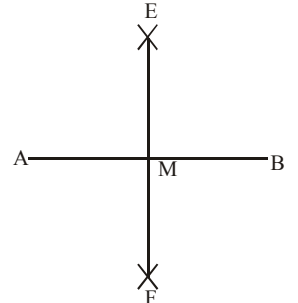 (a) II, I, III, IV
(a) II, I, III, IV
(b) II, I, IV, III
(c) I, II, IV, III
(d) I, II, III, IV'
 View Answer
View Answer 
Ans: (b)
Q47: Which of the following is the most accurate method to copy a given line segment?
(a) Trace method
(b) Ruler and compasses
(c) Protractor
(d) Divider only
 View Answer
View Answer 
Ans: (b)
Ruler and compasses method is most accurate method to copy a given line segment.
Q48: The successor of 498 + (-1015) is
(a) -517
(b) -516
(c) 516
(d) 517
 View Answer
View Answer 
Ans: (b)
We have, 498+(-1015) =- 517
Successor of-517=(-517) +1 =- 516
Q49: The sum of 46.009 and 146 is
(a) 192.009
(b) 129.9
(c) 182.99
(d) 179.09
 View Answer
View Answer 
Ans: (a)
Q50: A brick is broken down into two pieces in such that each piece is 0.009 m long. What would be the total length of the brick?
(a) 2.8 cm
(b) 1.8 cm
(c) 3.9 cm
(d) 4.1 cm
 View Answer
View Answer 
Ans: (b)
Since, each broken piece of brick = 0.009 m
Then, the length of both the piece of brick =0.009 m+0.009 m
=0.018 m =0.018×100 cm=1.8 cm
Hence, required total length of the brick is 1.8 cm
|
34 videos|123 docs|58 tests
|
FAQs on Maths Olympiad Model Test Papers -1 - Maths Olympiad Class 6
| 1. What topics are covered in the Class 6 Maths Olympiad Model Test Papers? |  |
| 2. How can I prepare effectively for the Class 6 Maths Olympiad? |  |
| 3. Are the Model Test Papers reflective of the actual Maths Olympiad exam format? |  |
| 4. What is the importance of Logical Reasoning in the Maths Olympiad? |  |
| 5. Where can I find additional resources for Class 6 Maths Olympiad preparation? |  |




















